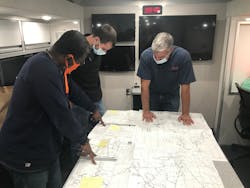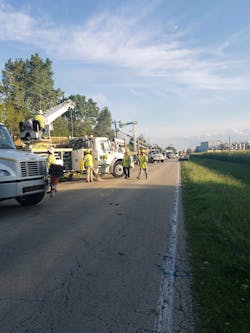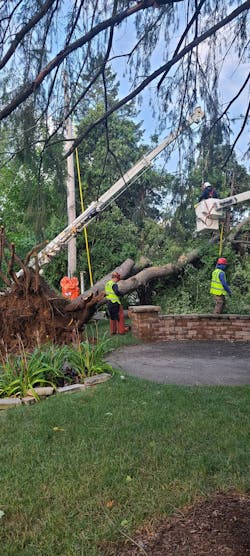After a derecho struck the ComEd service territory in the summer of 2020, impacting more than 800,000 customers, ComEd utilized an important component of customer restoration: Management Teams. As a result of the widespread damage, ComEd deployed five management teams to direct mutual assistance crews throughout the service territory in which ComEd was able to restore almost 520,000 customers in the first 24 hours.
“In order to ensure we are able to quickly bring power back to customers impacted by severe weather, we continue to explore innovative ways to effectively collaborate with the workforce to deliver safe and reliable electricity,” said Vito Martino, ComEd vice president of Distribution System Operations. “These management teams are deployed during significant weather events and provide us the ability to effectively restore customers in a localized, devasted area. Team members have unique skillsets, including leadership, crew management, and system and technical operation. Through deployment of this specialized management team, we can deliver a premier customer experience safely and effectively.”
The management team journey for ComEd started in the early 2000s when the ComEd service territory experienced a significant number of customer outages from a severe weather event. Multiple circuits from a substation experienced significant damage, and like most utilities, mainline restoration is managed within the distribution control center. The multiple cases of damage and number of circuits affected required a localized command and control restoration strategy. ComEd came up with a formal plan, including processes and procedures, to transfer designated authority control of all mainline restoration activities from the control center to managers in the field.
Once this process was refined, ComEd took it a step further by creating full-time Management Teams that would respond to areas devastated by weather. Each team member was selected to fill a role. Each role required a specific background for qualification.
Presently, ComEd has eight Management Teams that rotate primary and back-up duties every week. The team has evolved in not only restoring mainline outages but also providing oversight to a large number of mutual assistance crews, restoring all types of outages in a geographical area. In addition, the ComEd Management Teams has been successfully deployed outside of the ComEd service territory, adjusting the processes to however the host utility chooses to utilize the team, while maintaining the core functions and structure of the team.
Mutual Assistance is an important element of storm restoration for those utilities severely impacted by weather events. Requests for Distribution Line FTEs (full-time employees) are submitted and fulfilled through regional mutual assistance conference calls in which utilities in need may be challenged with managing the requested resources to restore their customers in a timely manner. To meet this challenge, the deployment of Management Teams can be utilized to manage the burden of those requested Distribution Line FTEs. They can be a very cost-effective resource for utilities in need of mutual assistance to leverage.
What Is A Management Team?
While various definitions of a management team exist, essentially it is a team of experienced management employees who can be deployed to utilities in need to provide localized command and control of customer restoration using mutual assistance crews. Typically, a management team comprises managers from various functions, such as construction and maintenance, distribution system operations, training and methods, and distribution engineering.
Required qualifications vary by role within the team. However, core qualifications are important for the team to be effective. At a minimum, the team should have a working knowledge of safety rules and work practices, exceptional knowledge of operating and construction work practices, and knowledge of distribution automation reclosers and schemes as well as other protective devices on the distribution system. Members of the team also should be proficient at patrolling feeders, be knowledgeable about restoration strategies, including restore vs. repair, and have a working knowledge of lock-out tag-out (LOTO) programs.
In addition, team members must be able to interpret operating maps, quickly adapt to the host utility’s processes and procedures, and navigate ambiguous conditions and situations. They also must be able to multitask under stressful conditions and provide leadership to both management and union personnel. Furthermore, they should take yearly training on team roles and responsibilities.
Roles And Responsibilities
The makeup of a management team in terms of roles and responsibilities can vary from team to team. However, the core functions of individuals on the team are fundamentally consistent from team to team. The number of FTEs deployed as part of a management team can vary between 10 to 14.
The management team lead oversees the overall management team’s activities and performance. This role assumes command and control of the assigned outages, managing restoration strategies. It leads daily team briefings and provides updates to the host utility’s leadership.
The team assistant assists in team logistics and securing materials. The assistant assigns, manages and tracks work packages, including estimated restoration times and actual restoration times, as well as determines dig locates. The assistant performs other duties as needed.
The team restoration controller and assessor develops a restoration plan in conjunction with the team lead and mutual assistance crew lead. This role also provides estimated restoration times, performs damage assessment and assesses material needs ahead of crews.
Services Provided
Because of a lack of resources to manage mutual assistance crews, utilities may be hesitant to ask for the distribution line FTEs required to restore customers in a timely manner, or they may be overwhelmed by the incoming mutual assistance crews. A management team can alleviate the burden of managing additional FTEs, enabling the host utility to bring on more resources and restore power more quickly.
A management team provides localized command and control of a designated area that requires focused restoration efforts because of significant damage. The host utility has a single point of contact when working with a management team, as opposed to having to interact with multiple mutual assistance crew leads. This enables the host utility to deliver one message vs. having to share with multiple mutual assistance companies.
In any restoration effort, crews can get lost in the chaos of a utility trying to manage a considerable number of mutual assistance resources, oftentimes waiting in public view for work assignments. A management team oversees approximately 125 FTE to 250 FTE mutual assistance resources on behalf of the host utility. The team provides localized oversight of the crews to ensure they are engaged and productive. In addition, the management team can stay ahead of crews in terms of damage assessment and securing materials in a timely manner. A crew’s next assignment can already be in the queue, thereby maximizing each resource.
A management team also provides the host utility with end-to-end outage management. To keep the utility’s customers updated, the team tracks outages for the utility — including estimated restoration times and subsequent restoration times — in a timely manner. Taking the administrative tasks of obtaining and managing work off the mutual assistance crew lead’s shoulders enables the lead to address individual issues or concerns with the utility’s crews, such as safety, discipline, meals and hotel accommodations.
Ultimately, a management team drives the restore vs. repair philosophy. Crews like to focus on finding and fixing issues. A management team has the mentality to look for opportunities to open taps, cut in bells and use other methods to restore as many customers as possible before repairs begin.
Successful Deployment
Not every utility in need will use a management team in the same manner. Some may use a team to supplement less-experienced crew guides who have no distribution restoration experience. Some may have a management team work in a given area on lateral taps, transformer and customer-level outages. Others may have a management team take over mainline restoration efforts. While the use of these teams is still not widely understood or utilized, it is imperative the host utility understands the management team concept and how such a team can aid in customer restoration.
One of the primary tools of a management team is a mobile command center. Having a fully equipped mobile office located near restoration efforts enables the team to provide a localized command and control structure. In addition, the management team must have a clear understanding with the mutual assistance crew lead the team is working on behalf of the host utility. Establishing that understanding and developing a close working relationship are important elements of restoration collaboration between the management team and mutual assistance crew lead.
With weather events becoming more pronounced because of climate change, utilities will be challenged to develop restoration strategies to satisfy customer expectations on being restored in a timely manner — no matter the damage a utility experiences. With this in mind, deploying a management team as part of a mutual assistance response can be an important part of a utility’s restoration strategy.
Timothy McThenia works for ComEd, an Exelon company. He has over 36 years of experience working in the electric utility industry, in which he has held positions in T&D construction for 14 years and distribution system operations for the past 22 years. He also provides managerial oversight to the ComEd management team, in which his team won the Edison Electric Institute Emergency Response Award for its response to Hurricane Ida in 2021.
About the Author
Timothy McThenia
Timothy McThenia works for ComEd (Exelon) which is headquartered in Chicago Illinois serving more than 4 million customers across northern Illinois. Tim has over 36 years of experience working in the electric utility industry in which he has held positions in T&D Construction for 14 years and Distribution System Operations for the past 22 years. He also provides managerial oversight to the ComEd Management Team in which his team won the Edison Electric Institute Emergency Response Award for their response to Hurricane Ida in 2021.



